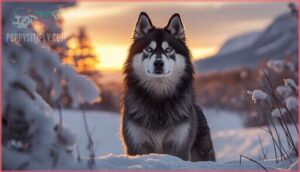This site is supported by our readers. We may earn a commission, at no cost to you, if you purchase through links.

These sharp-minded, fiercely loyal dogs demand respect, consistent training, and owners who understand that independence isn’t a flaw but a feature. Whether you’re drawn to their wolf-like masks and dramatic coloring or intrigued by their reputation as vocal, athletic problem-solvers, understanding what makes this breed tick separates successful owners from frustrated ones.
Table Of Contents
Key Takeaways
- Alaskan Klee Kai are compact, wolf-like companion dogs (10-17 inches, 6-25 pounds) bred specifically for apartment living and family companionship, not working tasks, yet they maintain the sharp intelligence, vocal nature, and independent streak of their Husky ancestors.
- These dogs form intensely loyal bonds with one chosen person but display natural wariness toward strangers, requiring early socialization (exposure to 200+ people before 16 weeks) to prevent lifelong anxiety and avoidance behaviors.
- Despite their small size, they demand 45-60 minutes of daily exercise plus substantial mental stimulation through puzzle toys, scent work, and dog sports—insufficient activity directly correlates with destructive behaviors and separation anxiety in 40% of under-exercised dogs.
- The breed’s double coat sheds heavily twice yearly for 3-6 weeks, their high intelligence makes them quick learners (85% master commands in under 10 sessions) but stubborn without engaging positive-reinforcement training, and they typically live 13-16 years with proper preventive veterinary care.
Alaskan Klee Kai Breed Overview
The Alaskan Klee Kai breaks the mold of typical companion breeds with its striking wolf-like appearance packed into a pint-sized frame. If you’re considering bringing one of these spirited dogs into your life, you’ll want to understand what makes them unique.
Let’s start with the foundational characteristics that define this exceptional breed.
Size and Weight Variations
Your Alaskan Klee Kai’s size won’t fit a one-size-fits-all box—this breed breaks into three distinct size categories. Toy versions stand up to 13 inches at the withers and weigh 6–14 pounds, while Miniatures measure 13–15 inches and tip the scales at 10–18 pounds. Standard Alaskan Klee Kai reach 15–17 inches tall with weight ranging from 16–25 pounds.
Height classification determines your dog’s category, not weight, and most reach full size by 13 months. Understanding the dog breed standards is essential for identifying the specific characteristics of your Alaskan Klee Kai.
Coat Colors and Appearance
Beyond size classifications, your Alaskan Klee Kai’s double coat creates its striking wolf-like aesthetic. Three standard coat color combinations dominate: black and white (most common), gray and white (roughly 45% of the population), and red and white (less than 20%). Shedding seasons hit twice yearly for 3–6 weeks, stripping about 30% of undercoat density. Understanding the coat color genetics is essential for breeders and owners alike.
Solid white dogs exist but can’t compete in shows due to missing mask contrast.
Key Coat Features You’ll Notice:
- Facial masks with symmetrical “goggles” and nose bar markings define that signature husky expression
- Eye color varies wildly—blue appears in 42% of dogs, but brown, amber, green, and even bi-eyed combinations occur
- Texture variations depend on outer coat length (25–40 mm), though all maintain a soft undercoat beneath
- Color genetics trace to MC1R gene variants, reducing dark pigment by 55% in red-coated lines
Breed Recognition and Standards
Those unique markings you’ve noticed aren’t just cosmetic—they determine whether your Alaskan Klee Kai qualifies for official breed standards. The United Kennel Club granted full recognition in 1997, establishing size divisions and mask requirements.
Your dog’s AKC breed information currently lists Foundation Stock Service status (added October 2020), the stepping stone before complete AKC recognition. Breed classification demands symmetrical facial masks, proper ear carriage, and curled tails—solid-colored dogs get disqualified instantly from kennel club competitions, no exceptions.
History and Origin of Alaskan Klee Kai
If you’re drawn to the Alaskan Klee Kai’s striking wolf-like appearance, you might wonder where this enchanting breed came from. The story begins in the 1970s in Alaska, where one breeder’s vision transformed carefully selected dogs into a distinctive companion breed.
Let’s explore how this breed developed, what it was bred for, and how it stands apart from its larger husky relatives.
Development and Ancestry
If you’re chasing breed origins, you’ll want to know that the Alaskan Klee Kai springs from a tight-knit crew of founder dogs. Linda S. Spurlin launched this project in Alaska between 1970 and 1988, blending genetic roots from northern working breeds into something entirely new.
- Founder Dogs: Just nine dogs formed the initial breeding pool
- Siberian Husky & Alaskan Husky: Core sled dog ancestry for appearance and stamina
- Schipperke: Added compact size and sharp alertness
- American Eskimo Dog: Contributed agility and trainable temperament
- Inherited Traits: Husky-type looks scaled down by roughly 55% in body mass
Purpose and Breed Evolution
From day one, companion life—not sled-pulling labor—drove every breeding decision behind the Alaskan Klee Kai. Linda Spurlin’s vision focused on size reduction and genetic diversity to craft a small, apartment-friendly dog that mirrored Husky looks without the working demands.
The Alaskan Klee Kai was bred for companionship, not labor—a miniature, apartment-friendly dog with Husky looks and family-friendly temperament
By 1997, the breed earned United Kennel Club recognition, cementing its evolution history as a family-focused companion with structured standards and adaptable temperament.
Distinction From Other Husky Breeds
Size offers the clearest dividing line: while Siberian Huskies tower at 20–24 inches and 35–60 pounds, you’ll find Alaskan Klee Kai measuring just 10–17 inches and 6–25 pounds—less than half the footprint.
Facial structure sets them apart too, with Klee Kai displaying symmetrical masks and stricter coat standards than their working Husky relatives.
Genetically, Klee Kai trace back to Spurlin’s 1970s hybrid program blending Huskies, Schipperkes, and American Eskimo Dogs, diverging entirely from the Alaskan Malamute’s ancient sled lineage or the Mini Husky’s downsized Siberian roots.
Temperament and Personality Traits
Understanding the Alaskan Klee Kai’s personality is key if you’re considering bringing one home. These dogs don’t fit the mold of your typical lap dog—they’re sharp, independent, and surprisingly vocal.
Let’s break down what makes their temperament unique and what you can expect when living with one.
Behavior With Family and Strangers
If your Alaskan Klee Kai bonds like superglue to one person but acts like a skittish cat around strangers, you’re seeing classic pack behavior in action. This companion dog exhibits strong loyalty traits and family bonding, often shadowing their chosen human everywhere. However, stranger anxiety runs deep—over 60% show wariness with new people.
Early dog socialization during puppyhood drastically improves Alaskan Klee Kai temperament, reducing avoidance behaviors and building confidence in unfamiliar situations.
Intelligence and Trainability
Think of your Alaskan Klee Kai as a quick study with an independent streak—over 85% master basic commands in under 10 training sessions. Their cognitive abilities place them in the top 15% of breeds for problem solving, but dog training success hinges on mental stimulation and the right learning modes.
Positive reinforcement yields a 92% improvement rate, while interactive play-based methods beat repetitive drills every time. Smart? Absolutely. Trainability shines when you match their sharp minds with engaging techniques.
Socialization Needs
Want your Klee Kai to thrive? Puppy socialization between 3-14 weeks is critical—exposing them to 200+ people before 16 weeks cuts adult shyness by 60%.
Human interaction through positive reinforcement boosts friendly greetings by 61%, while weekly environmental exposure slashes social reactivity by 33%.
Structured dog socialization reduces aggression incidents by 70%, and anxiety prevention starts with gradual, reward-based training that lowers separation anxiety symptoms by 48%.
Health, Nutrition, and Lifespan
While Alaskan Klee Kai are generally hardy, understanding their health profile helps you keep them thriving for years to come. Like any breed, they’ve a few genetic conditions worth knowing about, and their nutritional needs play a big role in their overall well-being.
Let’s break down what you need to know about keeping your Klee Kai healthy, properly fed, and around for the long haul.
Common Health Conditions
While generally hardy, you’ll want to watch for a few breed-specific concerns. Patellar luxation affects 10–15% of Alaskan Klee Kai, causing that telltale “skipping” gait.
Autoimmune thyroiditis can strike between ages two and six, bringing weight gain and lethargy. Factor VII deficiency—a bleeding disorder—shows up in 6–10% of the population.
Heart murmurs and cataracts round out the list, though cataract surgery restores vision in most cases when caught early.
Dietary Requirements
Your Klee Kai thrives on high-quality dog nutrition anchored by protein sources like chicken, beef, or fish—aim for 30% protein and 20% fat. Macronutrient balance matters: pair lean meats with vegetables (about 20% of the diet) such as sweet potatoes and green beans.
Feed adults twice daily; puppies need three to four smaller meals. Omega-3-rich sardines three times weekly, plus hydration needs met through fresh water and moisture-rich foods, round out proper canine diet care.
Consider nutrient supplements like zinc if thyroid concerns arise.
Life Expectancy and Preventive Care
Your Klee Kai usually lives 13–16 years, with some reaching 17 through preventive veterinary care. Lock in annual health screenings for patellar luxation, thyroid function, and cardiac exams. Vaccination schedules protect against distemper and parvovirus, while monthly parasite prevention guards overall dog health and care.
Don’t skip dental care—periodontal disease hits small breeds hard. Weight management and mental stimulation are key longevity factors that directly impact your Alaskan Klee Kai health conditions and life span trajectory.
Grooming, Exercise, and Training Needs
Alaskan Klee Kais don’t demand as much upkeep as you might expect, but they’re not exactly low-maintenance either. Between managing that thick double coat, keeping up with their energy, and channeling their sharp minds, you’ll need a solid game plan.
Here’s what it takes to keep your Klee Kai healthy, happy, and well-behaved.
Coat Care and Shedding
Your Alaskan Klee Kai sports a dense double coat that demands consistent attention—especially during shedding seasons. Expect biannual coat blowing episodes lasting two to four weeks, when tufts of undercoat fur accumulate rapidly throughout your home.
Weekly brushing manages routine maintenance, but daily sessions with slicker brushes and undercoat rakes become essential during peak shedding. Proper grooming tools preserve coat integrity while managing fur effectively.
Daily Exercise Requirements
Beyond managing that double coat, your Klee Kai craves substantial daily movement—plan for 45 to 60 minutes of physical activity to channel their ancient sled dog energy. These compact powerhouses thrive when exercise routines include variety and challenge.
Your dog’s exercise needs depend on age and energy levels:
- Daily walks: Two 30-minute sessions maintain cardiovascular health and behavioral balance
- High-intensity options: Jogging, hiking up to 5 miles, or secure off-leash running
- Interactive playtime needs: Fetch, tug-of-war, and hide-and-seek prevent boredom
- Low-impact alternatives: Swimming strengthens joints without stressing developing bones
Insufficient physical activity correlates with anxiety and destructive behaviors in 40% of under-exercised Alaskan Klee Kai.
Mental Stimulation and Dog Sports
Intelligence defines this breed—your Klee Kai needs mental enrichment as much as exercise. Scent work twice weekly improves focus and cuts destructive behaviors by 32% over two months. Puzzle toys hold attention for 20–40 minutes, while dog agility, nosework, and lure coursing satisfy their problem-solving drive.
Canine sports participation jumped 18% since 2022, with cognitive games reducing separation anxiety by 45%.
Training Tips and Techniques
Start training the moment your Alaskan Klee Kai puppy arrives home—puppies trained before 16 weeks retain commands 35% better than late starters.
Positive reinforcement and clicker training accelerate obedience commands like “sit” and “stay,” with rewards delivered within two seconds boosting learning speed by 30%.
Short sessions of 10–15 minutes twice daily keep focus sharp during housebreaking tips and agility training prep.
Reward systems work—they achieve over 90% success rates in properly socialized Klee Kai.
Frequently Asked Questions (FAQs)
Are Alaskan Klee Kais good with children?
When properly socialized from puppyhood, these dogs can thrive in family settings. However, their naturally reserved temperament means they’re often wary around rambunctious children.
Early socialization and constant supervision create the safest environment for positive kid interactions.
Are Alaskan Klee Kais easy to potty train?
Potty training this breed isn’t a walk in the park. Crate training methods help, but expect housebreaking challenges—especially with puppies.
Small bladders mean frequent accidents. Consistent training methods and exercise routines improve success, though some dogs take four to six months.
Can Alaskan Klee Kai be left alone?
Out of sight, out of mind” doesn’t apply to dogs—they feel your absence deeply. Adult Alaskan Klee Kai can handle 4-8 hours alone with proper crate training and exercise, but this companion dog breed is prone to separation anxiety.
Without anxiety prevention through gradual alone time training, expect destructive behaviors and dog loneliness when left too long.
How much does an Alaskan Klee Kai puppy cost?
Expect to pay between $2,000 and $3,500 for an Alaskan Klee Kai puppy from reputable breeders.
Puppies with champion bloodlines, rare coat colors, or exceptional conformation often command premium prices exceeding $3,000, while breeder reputation and geographic location also influence costs.
Are Alaskan Klee Kai good with children?
When raised alongside kids and properly socialized from puppyhood, these companion dogs can thrive in family dynamics. They bond well with older children who respect boundaries, but their small size and energetic temperament require parental guidance and household safety measures during play.
Do Alaskan Klee Kai have separation anxiety?
While not every dog in this breed struggles with being alone, Alaskan Klee Kai are prone to separation anxiety due to their high energy and alertness.
You’ll notice anxious barking, destructive behavior, or stress when they lack mental stimulation and proper training.
Conclusion
Choosing an Alaskan Klee Kai is like committing to a lifelong partnership with a wolf-spirited free thinker—they’ll challenge every assumption you have about what a “small dog” should be.
These sharp-minded companions don’t just want your affection; they demand your respect, consistency, and genuine understanding of their independent nature.
If you’re ready to match their energy, embrace their vocal quirks, and provide the mental stimulation they crave, you’ll discover a fiercely loyal adventure partner who turns heads everywhere you go.













